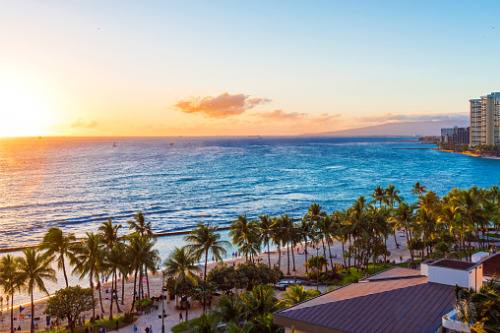New study from KBRA details problems in the Aloha State’s hotel industry

The US lodging industry is feeling the impact of the coronavirus crisis, and markets that rely heavily on tourism are the first to experience the fallout. Out in the Pacific, tourism is the largest economic driver in Hawaii, where lodging and retail segments are specifically expected to be impacted greatly. This, in turn, could create problems in the commercial mortgage-backed securities (CMBS) market.
“Hawaii is home to 18 lodging properties - $4.33 billion by allocated loan amount, that serve as collateral for 17 loans securitized in 25 CMBS transactions,” according to a new report by Kroll Bond Rating Agency (KBRA). In addition, the report says Hawaii is also home to “28 retail properties, including mixed use assets that are largely retail, collateralizing 28 loans ($2.95 billion) in securitizations.”
As hotel properties rely on daily room revenue for survival, the risk is immediate and the economic fallout is expected to continue. There are concerns that the decline in tourism travel will contribute to a very sudden decrease in the state’s cash flow.
Carl Bonham, executive director of the University of Hawaii Economic Research Organization (UHERO), told Hawaii Public Radio that the uncertainty is just enormous as to how long the spread continues. Bonham said that based on the data, Hawaii hotels will be lucky to achieve just 50% occupancy rate, compared to the average 80% to 90%.
Chris Tatum, president and CEO of Hawaii Tourism Authority, also recently announced that he is not inviting the Los Angeles Clippers back for an August preseason appearance this year amid coronavirus concerns.
While the severity of risk remains unknown, KBRA attempted to quantify the risk to lodging performance by applying net cash flow stresses for some popular hotel properties in Hawaii.
The Hilton Hawaiian Village Waikiki Beach Resort is the largest lodging loan in the state with $1.28 billion in debt securitized across nine CMBS transactions. The Honolulu hotel generated over $148 million in net cash flow during the year ending September 2019, according to the KBRA report. In the report’s projections, the stress test indicates a debt service coverage ratio of 1.77.
The resort announced on Friday it will start selling rooms as much as 30% off next week for stays running through most of 2020. Other hotels and resorts in Hawaii and other tourism-reliant organizations may end up doing the same, in order to drive business.
With the Four Seasons however, net cash flow was substantially lower last year compared to previous years. This could be attributed to the 2018 eruption of Kilauea Volcano.
“With consideration to the recent slump in reservations, our sensitivity analysis yielded a below-breakeven DSCR is each scenario,” the report stated.
Some hoteliers may try to offset losses by cutting employee hours, as well as reduce services offered to customers. But that may not be enough. UHERO is predicting the damage to Hawaii’s economy is going to result in a loss of more than 10,000 local jobs, with no guarantee of a quick bounce-back to a strong economic environment.
“As of March 10, 2020, we now expect visitor arrivals to fall sharply, by 13% in the second quarter and by more than 7% for the year as a whole,” said UHERO’s forecast report. “While recovery begins this summer, we do not expect it to be complete until next summer. There will be a substantial 17% decline in real visitor spending in the second quarter, followed by a prolonged recovery thereafter. With a sharp downturn in tourism and a long recovery period, our macroeconomic forecast for Hawaii is now much more pessimistic, with job losses of nearly 6,000 workers by the third quarter of this year, and a very restrained pace of hiring for the next several years.”



